 Image search results - "kannon" Image search results - "kannon" |

To Kannon-yama
|
|

The Kannon statue peers over the trees.
|
|

Standing 41.8 meters high, equivalent to a 9-story building.
|
|

Built in 1936.
|
|

Made of concrete.
|
|
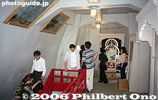
One of 20 Buddha figures inside the Kannon.During New Year's, many people visit the Kannon.
|
|
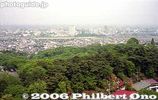
View from Kannon-yama.
|
|
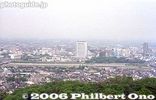
View of Takasaki. The tall building is Takasaki City Hall.
|
|
|
|
|
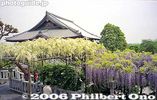
Wisteria
|
|
|

Kannon and bridge, Takasaki, Gunma
|
|
|

Arai Kannon statue. Wash the part of the body to cure the corresponding part of your own body. 洗い観音
|
|

They used to have a tawashi brush to wash the statue, but that wore out the statue. So the replacement statue is now washed/rubbed with a towel instead.
|
|

Jizo statue
|
|
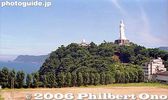
Giant Kannon statue in the distance.
|
|

View of bay, Kamaishi, Iwate
|
|
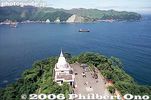
View of bay
|
|
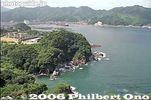
View of Kamaishi Port which was devastated by the tsunami in March 2011.
|
|

Kamaishi Dai-Kannon. She holds a fish.
|
|

Sensoji temple's Kaminarimon Gate. There's a large road in front and also a large paved area where festivals are held. 雷門
|
|

Symbol of Tokyo: Kaminari-mon Gate with a giant red paper lantern. Pass through this gate to reach Asakusa Kannon Temple. 雷門
|
|

One of Tokyo's most photographed buildings: Kaminari-mon Gate with a giant red paper lantern.
|
|

Giant red paper lantern with the kanji characters "Kaminari Mon." The gate was reconstructed in 1960. The previous one was lost in a fire in 1865.
|
|

Under the lantern on the gold cap, there's "Matsushita Denki" (Matsushita Electric Industrial Co. or Panasonic). The current Kaminarimon Gate and giant lantern were rebuilt in 1960 as a donation by Konosuke Matsushita.
|
|

The lantern is covered with a protective net. The lantern can be collapsed like an accordion to allow tall objects (such as a mikoshi portable shrine during the Sanja Matsuri festival) to pass under the gate. It is also collapsed during typhoons.
|
|
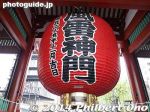
The famous Kaminarimon lantern was replaced with a new one in Nov. 2013. This is the back.
|
|
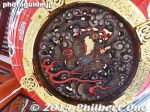
The bottom of the new Kaminarimon lantern has this nice artwork.
|
|

The temple is also called Kinryuzan, meaning Golden Dragon. 金龍山
|
|
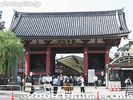
An unusual time when the giant lantern was removed for repairs. Asakusa looks very strange, almost naked, without the giant lantern.
|
|

After passing through the Kaminarimon Gate, this is what you see: Nakamise shopping arcade. When it rains, a canopy is put up.
|
|

Nakamise-dori souvenir arcade. One of Japan's most popular and crowded tourist arcades.
|
|

In spring, a cherry blossom motif is put up.
|
|

At the end of the year and New Year's, auspicious red and white and New Year's decorations are put up.
|
|

Nakamise sells all kinds of Japanese things. Originally, they catered to religious pilgrims. Now it's mostly tourists.
|
|
|

Kimono shop
|
|

Kimono shop
|
|

Traditional footwear
|
|

Paper umbrellas
|
|

Trinkets
|
|

Small Kannon statues for 25,000 yen.
|
|

Approaching another gate called Hozomon Gate. 宝蔵門
|
|

Hozomon Gate ahead. 宝蔵門
|
|
|

Hozomon Gate, means "Treasure Storage Gate." Indeed, the second floor houses important cultural properties. The gate was reconstructed in 1964, a ferroconcrete building.宝蔵門
|
|

Being the main gate, Hozomon Gate is much bigger than Kaminarimon Gate, and it also had a giant paper lantern.
|
|

Hozomon Gate
|
|

Hozomon Gate's giant paper lantern.
|
|
|

Behind Hozomon Gate is a pair of giant straw sandals hanging on the wall.
|
|

Giant straw sandal.
|
|

Sometimes on the way to Sensoji temple in Asakusa, you might see stalls selling seasonal gifts like the Hozuki Ground Cherry Pod Fair held on July 9th–10th.
|
|
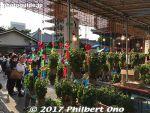
Hozuki Ground Cherry Pod Fair held annually on July 9th–10th.
|
|

Hozuki Ground Cherry Pod Fair held on July 9th–10th in Asakusa.
|
|

Hozuki Ground Cherry Pod Fair held on July 9th–10th.
|
|

5-story pagoda reconstructed in 1973, made of ferroconcrete. Roof tiles made of aluminum alloy. 五重塔
|
|

Place to buy a omikuji fortune paper.
|
|
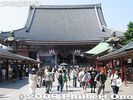
Hondo worship hall was reconstructed in 1958, made of ferroconcrete. The original Hondo was built in 1649 and a National Treasure until it was destroyed during World War II. 本堂
|
|

Hondo worship hall 本堂
|
|

Incense burner always attracts a crowd.
|
|

Incense burner
|
|

Incense burner
|
|

Incense burner. Pat the smoke to the part of your body that needs to be healed.
|
|
|

Water fountain 沙竭羅龍王像
|
|

Hondo worship hall 本堂
|
|

Steps going up to the Hondo main worship hall.
|
|
|

Going to worship.
|
|
|
|
|
|

View from Hondo worship hall
|
|
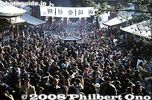
Crowd during New Year's
|
|

Inside Hondo worship hall 本堂
|
|

Hondo worship hall 本堂
|
|
|

Hondo worship hall altar 本堂
|
|

Prayers in front of the altar and offertory box.
|
|

Paintings on ceiling inside Hondo worship hall.
|
|

Painting on ceiling of Hondo worship hall.
|
|
|
|

Hondo worship hall side view 本堂
|
|

Hondo worship hall side view 本堂
|
|
|

Nitemon Gate in the east undergoing renovations. One of the few original buildings still intact. 二天門
|
|
|
|
|
|
|
|
|
|
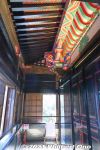
Corridor facing the Funa-roka.
|
|
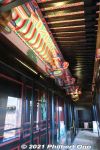
Corridor facing the Funa-roka.
|
|
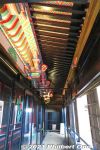
Corridor facing the Funa-roka.
|
|
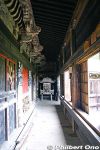
Corridor facing the Funa-roka before the restoration. Everything was drab looking. After the restoration, the windows on the right are now kept closed.
|
|
|
|
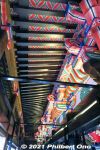
Decorative wooden support assemblages called tokyo (枓栱) or dougong. They are now illuminated to show off the vibrant colors.
|
|
|
|
|
|

Corridor and incense burner in front of the altar. The wooden pillars totally re-lacquered.
|
|
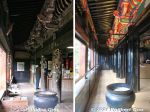
Before-and-after photos of the corridor in front of the altar. The wooden pillars that used to be covered with pilgrim name stickers are now all gone. Pillars totally re-lacquered. 観音堂
|
|
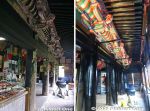
Before-and-after photos of the corridor in front of the altar. The wooden pillars that used to be covered with pilgrim name stickers are now all gone. Pillars totally re-lacquered. 観音堂
|
|
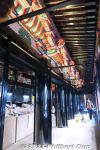
Above the pillars are decorative wooden support assemblages called tokyo (枓栱) or dougong. They have also been brilliantly repainted and even lit up. Dougong are interlocking wood pieces commonly found on temples and shrines as a Chinese influence.
|
|

In front of the main altar of Kannon-do. The hall worships a thousand-arm Kannon statue (hidden from the public).
|
|
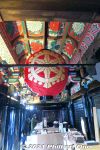
Ceiling in front of the altar includes a red paper lantern.
|
|
|
|
|

Candle holder.
|
|
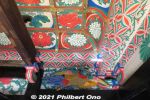
Kannon-do ceiling and transom carvings.
|
|
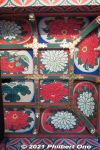
Ceiling paintings of flowers.
|
|
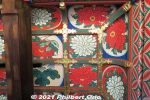
Kannon-do ceiling of painted flowers. Peonies (red), chrysanthemum (white), and paulownia (blue). 牡丹、菊、桐
|
|
|

Kannon-do ceiling of painted flowers. Peonies (red), chrysanthemum (white), and paulownia (blue). 牡丹、菊、桐
|
|
|
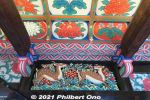
Kannon-do ceiling and transom deer carvings.
|
|
|
|
|
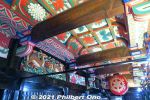
Kannon-do ceiling and transom carvings. Absolutely brilliant colors.
|
|
|
|

Corridor in front of the altar.
|
|
|
|
|
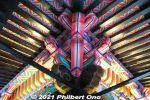
Kannon-do Hall roof corner with a tokyo assemblage. So much eye candy in this building.
|
|
|
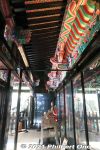
Heading toward the statue of Pindola Bharadvaja. The carved walls are now protected with plexiglass.
|
|

Before photo of the statue of Pindola Bharadvaja and the nearby wall with flower carvings.
|
|
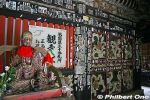
Before photo of the statue of Pindola Bharadvaja and the nearby wall with flower carvings. (See the next photo after the restoration.)
|
|
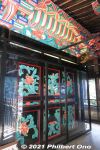
After photo of the restored wall flowers near the statue of Pindola Bharadvaja.
|
|
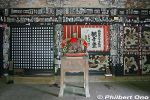
Before photo of a very old and worn statue of Pindola Bharadvaja (賓頭盧尊者). Traditionally, you touch his body part corresponding to the part of your body you want to heal. Notice the pillars and ceiling beams which were plastered with pilgrim name stickers called "senjafuda" (千社札). They bear the ardent pilgrim's name and pilgrims stuck their name stickers on the temples they visited to indicate "I wuz here!"
|
|
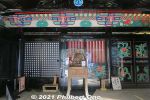
After photo of Pindola Bharadvaja statue. These days, best not to touch unless you use hand sanitizer afterward.All those old pilgrim name stickers (mostly from the Edo Period when it was fad) were removed for a new layer of lacquer.
|
|
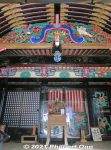
Pindola Bharadvaja statue right inside Karamon Gate.
|
|
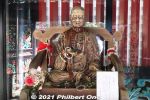
Worn statue of Pindola Bharadvaja (賓頭盧尊者).
|
|
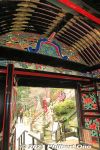
Inside Karamon Gate. Just gorgeous. Too bad most people just walk in without looking back and noticing.
|
|

Approach to Doganji (also called Kogenji) Temple. 10-min. walk from JR Takatsuki Station. 渡岸寺観音堂(向源寺)MAP
|
|

Kogenji Temple in Takatsuki, Nagahama belongs to the Buddhist Jodo Shinshu Sect (Otani school). On the left of this main hall is the Doganji Kannon Hall where the 11-face Kannon statue (National Treasure) can be viewed. 渡岸寺観音堂(向源寺)
|
|

Inside Kogenji Temple main hall. Admission to see the Kannon statue is 300 yen. Open 9 am - 4 pm. Parking available. Appointment not necessary to see the Kannon statue.
|
|

Picture taking of the Kannon statue is not allowed. The statue was carved by Taicho 泰澄 in the 8th century for Emperor Shomu. During the war between the Azai and Oda Nobunaga, the temple was burned. But the statue had been buried and was saved.
|
|

Kannon Folk History Museum (Kannon no Sato Rekishi Minzoku Shiryokan) has various exhibits about Kannon and the town's historical persons. 観音の里歴史民俗資料館 MAP
|
|

Inside Kannon Folk History Museum, which is near Doganji and 10-min. walk from Takatsuki Station. The museum opened in 1984. Admission 250 yen. Museum hours 9 am - 4:30 pm. Closed Mon., the day after national holidays, and year end/New Year's.
|
|

Guide to Kannon statues in Takatsuki. On the left is the National Treasure Kannon statue at Doganji temple. One of seven 11-face Kannon statues in Japan which is a National Treasure. This one is said to be the most beautiful. 十一面観音立像
|
|

Tourist map of Takatsuki which has quite a few temples with a Kannon statue.
|
|

Takatsuki Kannon Temple (Daienji temple) is also near Takatsuki Station, in the south. Temple noted for a 1000-arm Kannon statue. 大円寺 MAP
|
|

Entrance to Takatsuki Kannon Temple (Daienji temple).
|
|
|
|
|
|

Takatsuki Kannon Temple (Daienji temple), main hall. 大円寺
|
|

Inside Takatsuki Kannon Temple (Daienji temple).
|
|

Autumn at Takatsuki Kannon Temple
|
|

Path to Kiyomizu-dera is a slope lined with souvenir shops, a tourist trap.
|
|

Gate
|
|

Kiyomizu-dera Gate
|
|

Start of the Blue Dragon dance (Seiryu-e) at Kiyomizu-dera, Kyoto.
|
|

This is Seiryu-e, a blue dragon dance held near the steps on March 15-17, April 3, and Sept. 15-17 at 2 pm. 青龍会
|
|

The Seiryu-e includes a procession of native-attired men.
|
|
|
|
|
|
|
|
|
|

Deck of Kiyomizu-dera main hall
|
|

Kiyomizu-dera temple on wooden stilts. Kiyomizu-dera belongs to its own independent Buddhist sect.
|
|

Kiyomizu-dera is the 16th temple in the Saigoku Western Japan pilgrimage circuit. The Hondo main hall dates from 1633.
|
|
|
|
|

Kyoto Tower in the distance as seen from Kiyomizu-dera.
|
|

Otowa no Taki waterfalls 音羽の滝
|
|

Otowa no Taki waterfalls
|
|
|

Kannon statues
|
|

Close-up of Kannon statue
|
|
|
|
|
|
|
|
|
|

Kannon at the top of the slope.
|
|
|
|
|
|

Bottom of slope
|
|

Adjacent to Tokugen-in temple is Kiyotaki Jinja Shrine with stone lanterns.
|
|
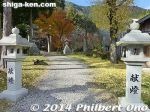
Kiyotaki Jinja Shrine
|
|
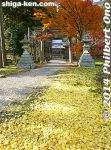
Gingko leaves
|
|
|
|
|
|

Bridge to Kiyotaki Jinja Shrine
|
|
|

Kiyotaki Jinja Shrine 清滝神社
|
|
|
|

Kiyotaki Jinja Shrine
|
|

View from Kiyotaki Jinja Shrine
|
|

Kiyotaki
|
|
|
|
|
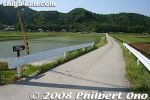
Turn in here to go to Kannonji temple in Maibara.
|
|
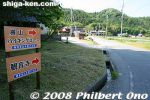
Way to Kannonji temple in Maibara.
|
|
|
|
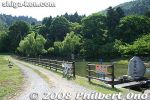
Pond in front of Kannonji temple in Maibara.
|
|

Kannonji Pond 観音寺池
|
|
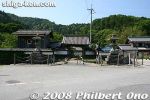
Gate of Kannonji temple in Maibara. Kannonji temple is noted as the place where Toyotomi Hideyoshi rested during falconry session when he met Ishida Mitsunari who was studying at the temple.
|
|
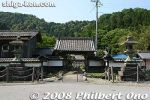
Gate of Kannonji temple in Maibara. MAP
|
|
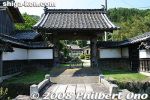
Kannonji temple in Maibara. It belongs to the Tendai Buddhist sect.
|
|
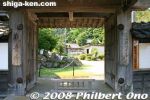
Gate to Kannonji temple.
|
|
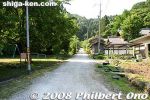
Omote path in Kannonji temple in Maibara.
|
|

About Kannonji temple in Maibara.
|
|
|

Well where Ishida Mitsunari fetched water for tea he made for Toyotomi Hideyoshi in three servings. 観音寺 水汲みの井戸
|
|
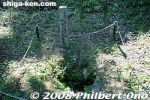
Well where Ishida Mitsunari fetched water for tea he made for Toyotomi Hideyoshi in three servings at different temperatures to quench Hideyoshi's thirst well.
|
|

About Mitsunari servng tea to Hideyoshi.
|
|

Map of Kannonji temple grounds.
|
|
|

Steps to the Hondo main hall of Kannonji temple.
|
|
|
|
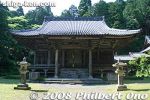
Kannonji temple Hondo main hall in Maibara, Shiga. Ishida Mitsunari was suppsedly a young monk here where he met Toyotomi Hideyoshi.
|
|
|
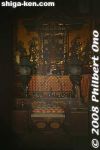
Altar inside Hondo.
|
|

About the Hondo hall.
|
|
|
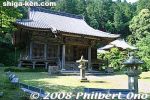
Kannonji
|
|
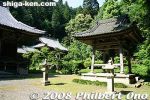
Kannonji temple bell.
|
|
|
|
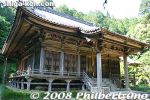
Kannonji temple Hondo
|
|
|
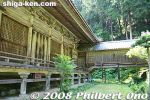
Corridor connecting the Hondo to the Yakushido Hall.
|
|
|
|
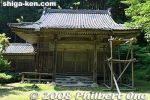
Yakushido Hall 薬師堂
|
|
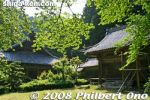
Hondo on left and Yakushido on right.
|
|
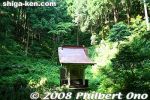
Little shrine nearby.
|
|
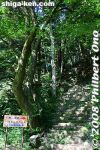
A little path lined with little Kannon statues at Kannonji.
|
|
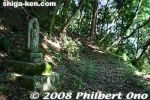
Kannon statue at Kannonji.
|
|
|
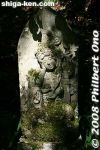
Kannon statue at Kannonji temple.
|
|
|
|
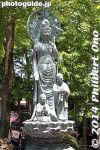
Kannon statue
|
|

The city of Nagahama boldly opened a little museum in Ueno, Tokyo called “Biwako Nagahama Kannon House” (びわ湖長浜 KANNON HOUSE) on March 21, 2016.
|
|

The museum is small, but nice. It has only one medium-size room divided into the kannon exhibition space and a mini theater showing a video about Nagahama.
|
|
|
|

“Biwako Nagahama Kannon House” (びわ湖長浜 KANNON HOUSE)
|
|

It exhibits one precious kannon Buddha statue (Goddess of Mercy) brought over from Nagahama, Shiga Prefecture. The exhibit changes every two months so Tokyoites can see six different kannon statues from Nagahama every year.
|
|
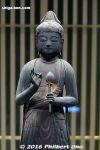
This Kannon is from Sonju-in temple (尊住院) in Nagahama’s Kawamichi-cho district.
|
|
|
|